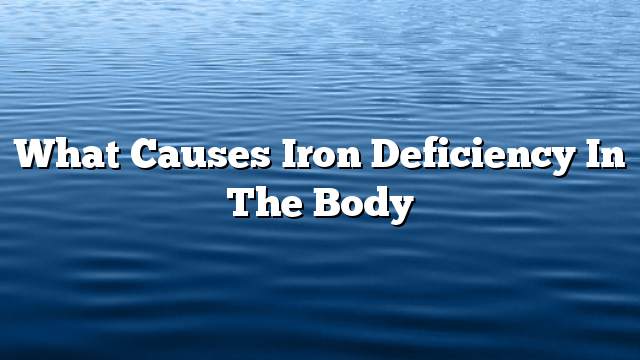The importance of iron in the body
Iron is an important organ for all cells of the body. It has many benefits and functions. It is in the form of many enzymes that help the body digest food. Iron also enters the hemoglobin structure, which takes oxygen from the lungs to the rest of the body. the blood.
Symptoms of iron deficiency in the body
Usually, no symptoms or signs of iron deficiency appear in the early stages of the blood, only after they turn into anemia. Since the lack of iron affects the entire body, it is necessary to observe the groups that are susceptible to regular deficiency.
Symptoms and signs of iron deficiency in the body include:
- Feeling weak and tired.
- The weakness of the immune system so that the body is more susceptible to infection.
- Tongue inflammation.
- Temperature disturbance.
- The decline in practical and academic performance.
- Slow social and cognitive development in children.
Iron functions in the body
There are many functions of iron in the body, the body needs iron for growth and development, and include iron functions include:
- Convey oxygen from the lungs to all tissues of the body.
- Plays a role in the process of metabolism; being one of the elements of some proteins and enzymes.
- Plays a role in the building of connective tissues and some hormones.
Factors affecting the absorption of iron
The amount of iron absorbed by the body depends on several factors, including the following:
- The use of stomach ulcers, or antacids in overdose reduces the ability to absorb iron.
- The source of animal iron (heme) of meat, chicken and fish is absorbed in two to three times larger amounts than iron from a non-heem plant source.
- Taking vitamin C with a non-animal iron source enhances the ability to absorb it.
- The type of food eaten with the plant containing the iron affects the extent of its absorption.
- Eating the animal’s source of iron with other sources enhances its absorption.
- The source of non-animal iron with substances containing polyphenols, phytates or calcium, found in some foods and beverages, including whole grains, dairy products, tea and coffee, reduces the amount of iron absorbed from the meal itself.
- The intake of animal iron sources with calcium in the meal itself reduces the absorption of iron.
- Vegetarians do not get sufficient amounts of iron from animal sources or may not get it at all, but adherence to a specific diet helps to increase the limit = hand that is absorbed.
Categories need more iron
There are many situations that lead to the need of the body for more iron, including the following:
- pregnant woman : They need more iron.
- Baby or pre-school child: Because it is growing rapidly compared to other children.
- Those who lose blood: This is due to many reasons. Those who lose blood lose iron as a component of hemoglobin, and blood loss may occur due to several factors, including infectious, intestinal, and excessive blood donation, as well as excessive menstruation in some women.
The most vulnerable groups are iron deficiency
The groups most prone to iron deficiency are:
- Adults with internal hemorrhage: Those who have internal bleeding may suffer from this deficiency; they lose a lot of iron with bleeding blood. Cases that lead to internal bleeding include hemorrhagic ulcers and colon cancer. There are also some drugs that may lead to internal bleeding, including aspirin.
- Infants and Toddlers: They need iron for growth and development, and children born with a low weight or prematurely need more iron than their peers, and it is reported that drink a lot of cow’s milk are more prone to iron deficiency anemia.
- Teenagers: They are more likely to have this condition if their weight is too low or they are chronically ill. Adolescents are also vulnerable if they have a heavy menstrual period.
- Women of reproductive age: They are also vulnerable to this condition if they are proliferating or pregnant. Pregnancy makes them need the low amounts of iron they need without pregnancy, because the blood volume increases with the pregnancy to help the fetus grow, and about half of the pregnant women suffer from this deficiency, They have premature babies, or have little weight.
Diagnosis of iron deficiency in the body
If a person is diagnosed with iron deficiency anemia, the doctor will take the patient’s history and symptoms, as well as a clinical examination, during which the doctor will ask the person about the diseases he or she has suffered,
The diseases of his family members, his eating habits, and the use of drugs, in addition to the bleeding, especially if this in women during pregnancy and menstruation.
The tests that the doctor asks the person to confirm the diagnosis include the following:
- Iron test: Which measures the amount of iron in the blood, so as to determine the type and severity of anemia.
- Test levels of veritene: Which shows the amount of iron stored in the body.
- Retinal cell count: To determine the cause of anemia.
- Full blood count: To identify the color, number, size and shape of blood cells.
Iron sources
Iron sources include:
- Red meat is fat free, especially if it is old.
- Liver.
- Eggs, especially its whistles.
- Chicken.
- Dried fruits.
- Broccoli.
- Spinach.
- Whole grains.
- Cereals supported by iron.
- Almonds.
- Wheat.
- Brown rice.
